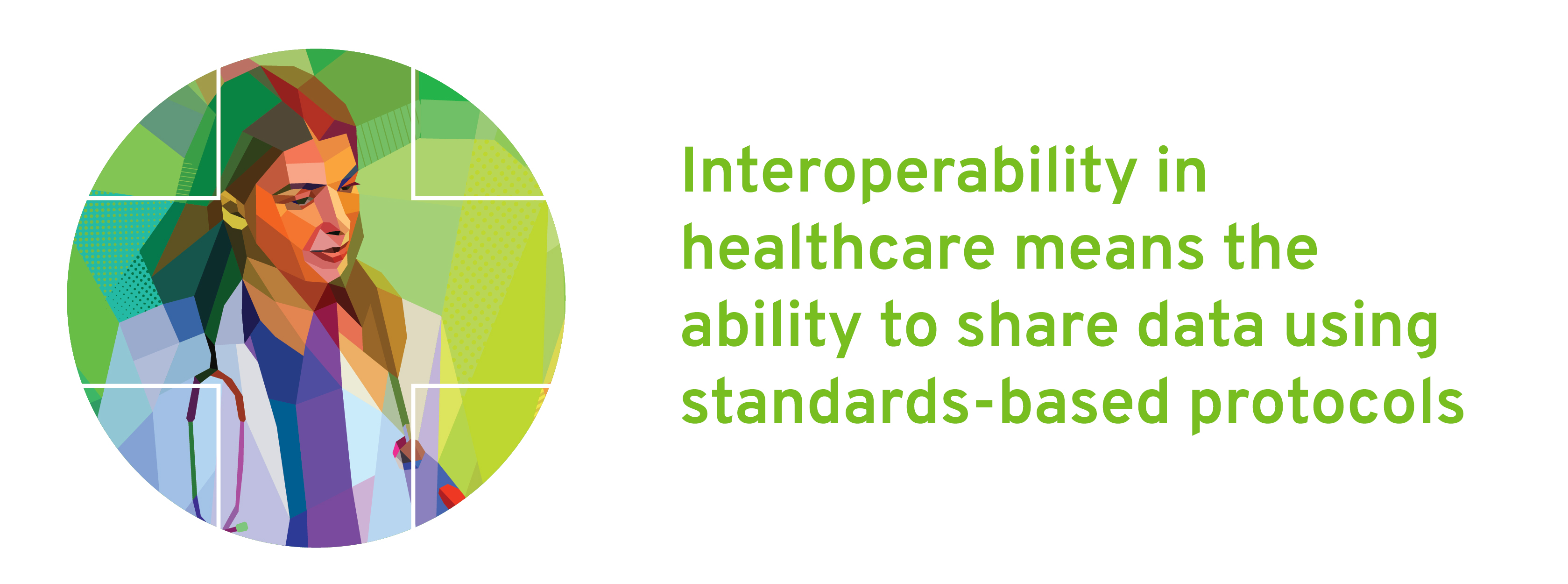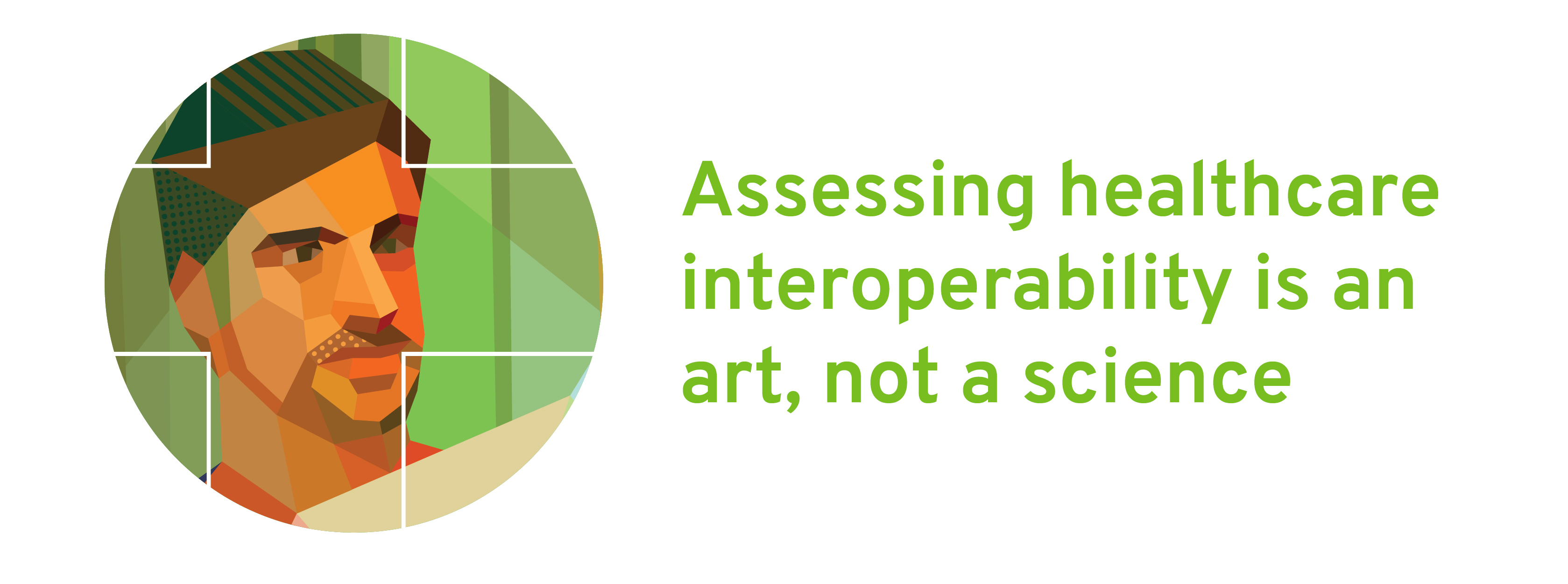Healthcare leaders contend with many challenges. Controlling costs, responding to consumerism in the marketplace, staying ahead of changes and upgrades in healthcare technologies, and maintaining regulatory compliance are some of the concerns that keep leaders awake at night. Interoperability is a central element of all of these challenges.
The enterprise interoperability decisions an organization makes can mean the difference between:
- Efficient operations versus costly and bespoke models
- Happy consumers with streamlined access to their health records rather than time consuming and manual release processes
- Optimized technology and clinical workflows versus double documentation and bloated notes
- Regulatory compliance versus penalties
A mature interoperability position can help organizations address these significant problems.

Defining interoperability in healthcare
At the most basic level, interoperability in healthcare means the ability to share data using standards-based protocols. Imagine every health system, payer, and health IT vendor is its own country and speaks a unique language. Interoperability is the translator that allows effective communication between all parties. Interoperability refers to the ability to share patient data internally, for example between an organization's electronic health record (EHR) and a separate software system, such as a billing system.
Interoperability also refers to data sharing that takes place between the organization and external parties. For example, it could mean sharing data between a healthcare organization and a patient via a patient portal. Or it could mean sharing data between the organization and a third party, such as an independent rehabilitation center.
Standards-based protocols such as FHIR and HL7 v2 are the core of interoperability. But interoperability is only effective if the shared data are high-quality. That is, both the sender and the receiver must have data that are:
- Accurate
- Valid
- Consistent
- Timely
- Relevant
- Complete
- Accessible
In addition, interoperability includes the processes that ensure the security and privacy of the electronic data created, transmitted, received and/or maintained by the sender and receiver. In other words, the HIPAA Privacy Rule and the HIPAA Security Rule apply to interoperability processes.
Learn more about increasing data quality through data governance

Why does interoperability matter?
Interoperability enables technologies to provide new functionalities, to be integrated faster, to acquire and use more data, to write back to the EHR, or to share data more broadly with lower overhead.
With interoperability in place, organizations are able to leverage technology to enable improvements. In other words, interoperability makes it possible to fully realize the benefits of healthcare’s digital transformation. Those benefits include:
- Better clinical outcomes. When clinicians have access to comprehensive, real-time patient data, they can make better decisions, resulting in better patient outcomes.
- Empowered patients. Patients want — and need — access to their medical data. A patient who is informed about and engaged in their medical care is more likely to adhere to treatment recommendations, including medication regimes.
- Satisfied employees. Clinicians want to use technology that enables their work. Technology implementations often result in more work for clinical staff, not less. Interoperability is the key to enabling strong technical integrations that help, rather than hinder, workflows.
- Increased operational efficiency. Operational inefficiencies create drag on the organization. Inefficiencies can burden staff with redundant workflows and can contribute to problems ranging from inadequate patient care to overstaffing or understaffing. Interoperability enables innovative technologies that can reduce bottlenecks and facilitate automation.
- Better financial outcomes. Interoperability facilitates data sharing that makes it possible to glean insights and identify hidden problems by analyzing previously disconnected data. Like all improvements in efficiency, improving the effectiveness of the organization’s technology via interoperability can benefit the organization’s financial performance as well.
- Regulatory compliance. Regulatory compliance is non-negotiable. Healthcare organizations that are not compliant with interoperability regulations may be subject to penalties or bad press, negatively affecting the bottom line. Investing in enterprise-wide interoperability can help organizations comply with current regulatory requirements and prepare for future rules.

Interoperability regulations
For more than a decade, the U.S. Department of Health and Human Services (HHS) has nudged healthcare organizations farther along the path to interoperability. Since the passage of the Health Information Technology for Economic and Clinical Health (HITECH) Act in 2009, HHS has used a carrot (incentives) and stick (penalties) approach to push the healthcare ecosystem closer to standards-based data exchange. First, it incentivized healthcare organizations to adopt EHRs via the Centers of Medicare & Medicaid Services (CMS) EHR Incentive Programs. Next, it incentivized organizations to use and share digitized patient information (e.g., Meaningful Use).
The EHR Incentive Programs have now been subsumed into the CMS Promoting Interoperability Programs. The rebranding reflects the government’s continuing interest in advancing interoperability throughout the U.S. healthcare ecosystem.
Subsequent legislation, such as the 21st Century Cures Act, signed into law in 2016, continues to move healthcare organizations to connect the dots and fulfill the promise of interoperability. The 21st Century Cures Act Final Rule, published in March 2020, has continued the incremental drive toward mature interoperability.
Among other requirements, the Patient Access and Interoperability Rule calls on the healthcare industry to adopt FHIR application programming interfaces (APIs) and sets ground rules on data availability via those APIs. This provision is designed to facilitate patient and 3rd party access to personal healthcare information. In addition, the final rule requires healthcare organizations to enable patients to access all of their information electronically quickly and at no cost to the patient.

Levels of interoperability
Interoperability is a journey, not a one-and-done project. The path to maturity in interoperability is complex; decisions you make today and into the future can hinder or improve how your ecosystem interoperates. It is also cumulative. In other words, standardized interoperability requirements at a basic level can lay the foundation for more complex achievements later on.
The Healthcare Information Management and Systems Society (HIMSS) has defined four levels of interoperability:
- Level 1: Foundational. This is interoperability in its most basic form. It refers to setting up secure interconnectivity between one system or application and another. At this level, the receiving system does not have to interpret the data it receives; it only has to be able to receive it. Digital faxing is an example of Level 1 interoperability.
- Level 2: Structural. Structural interoperability refers to data exchange that uses defined formats, syntax and data organization. Data standards, such as Health Level Seven (HL7®) Fast Healthcare Interoperability Resources (FHIR®), come into play here. Data standards enable data exchange and interpretation at the level of the data field.
- Level 3: Semantic. Semantic interoperability leverages models and data codes to support a more meaningful level of data sharing. At this level, data sharing involves more than field-level data exchange. In addition, semantic interoperability refers to the transmission of the meaning of the data (metadata) along with the data elements.
- Level 4: Organizational. The highest level and most aspirational level encompasses the organizational context needed to facilitate interoperability. This includes governance structure, enabling policies and procedures, and other aspects of the connectivity ecosystem. Achieving this level of interoperability will not only require an aligned and connected organization, but also technological innovations that ensure the seamless and secure exchange of data

Barriers to achieving interoperability
Identifying and executing on a strategy for mature data sharing can be challenging. The challenges of advancing interoperability reflect the amorphous nature of the problem.
- Lack of standardization. The development of standards is advancing. But for standards to be useful, they not only have to be developed and vetted, they must also be adopted and used consistently and widely. To that end, the Final Rule of the 21st Century Cures Act adopted FHIR and the United States Core Data for Interoperability (USCDI) as a standard. The USCDI consists of a standardized set of health data classes, typically supported as FHIR resources, and their associated data elements. Adoption of FHIR and the USCDI is just one of the many steps necessary to connect the dots across the healthcare ecosystem.
- Complexity of solutions. An initiative as important as making electronic patient data available in the patient portal may involve a multitude of different technologies and applications. In most healthcare organizations, patient data is found not just in the EHR, but in other applications. Making a complete patient record available means addressing each of the component solutions required to make the complete patient record available.
- Skills gap. Large healthcare organizations may have significant IT teams but lack expertise in interoperability standards and technologies. Smaller organizations may struggle to hire IT staff with the skills they need. Regardless of organization size, most IT teams are focused on their immediate operational problems. Finding, hiring, and allocating IT staff time to support technical integrations can be a stretch for many healthcare organizations.
- Other resource limitations. Healthcare organization budgets are besieged by many competing priorities. The complexity of addressing a single integration can make it tempting for organizations to seek the fastest interoperability solution rather than a scalable one. Data interoperability decisions today will have a lasting impact on your business. Make the right choices for the future by laying a technical and organizational groundwork for interoperability.

Assessing healthcare interoperability at your organization
Assessing healthcare interoperability is an art, not a science. There is not a single tool, measurement, or program that will let you know where your organization is with respect to interoperability.
You may, however, already be aware of interoperability-related pain points in your organization:
- Do you have patient data stored in unconnected data silos, and you aren’t sure how to connect the dots?
- Do any key processes in clinical workflows still require double documentation?
- Are staff using unsanctioned workarounds or guerilla databases to get around inefficient processes?
- Are you struggling with value-based care requirements, and aren’t sure how to consolidate data in a meaningful way?
- Have patients complained about incomplete medical record information in the patient portal, or do staff spend significant energy to release information?
- Have patients filed complaints with the HSS Office for Civil Rights (OCR) because of problems related to accessing their medical records?
If your organization is experiencing any of these problems, or problems like them, your first step is to engage the services of a healthcare technology partner that can “look under the hood” and identify the specific technical and operational problems that are at the root of your issues.
Learn more about assessing your organizations unique interoperability challenges

Addressing interoperability challenges
Interoperability challenges are as unique as each of the organizations that make up the connected healthcare ecosystem. That is why it is important to leverage the expertise of a trusted partner to analyze your organization’s specific interoperability challenges.
The right partner will bring expertise in four areas that contribute to implementing effective interoperability solutions:
- Interoperability advisory services: In a partner, you need broad experience in health information technology and deep expertise with interoperability standards and technologies. Exposure to a wide variety of healthcare organizations (large, small, providers, payers, etc.) means your technology partner is more likely to have encountered problems like yours. That enables them to deploy their expertise efficiently when addressing your interoperability challenges based on industry best practices.
- Cloud expertise: The right solution often leverages existing technologies and feature sets. An experienced technology partner can recommend the appropriate infrastructure to address your organization’s interoperability challenges. In addition, a vendor-agnostic partner with experience across a wide variety of integration suites will have the expertise to recommend the right solution to fit your needs.
- Cybersecurity expertise: Interoperability solutions must address the delicate balance between access to information and protecting the privacy and security of that information. Your technology partner should have expertise in cyber risk management and cybersecurity.
- Data and analytics expertise: Organizations that want to extract the full value from their investments in interoperability will want to partner with an organization that has expertise in data and analytics. The real ROI in interoperability comes from analyzing data and using those insights to improve everything from clinician decision-making to revenue cycle management. The right partner can help an organization leverage their interoperability solutions to optimize ROI.
Let’s Connect
Get started with a free consultation on how your organization can improve interoperability today.

More interoperability resources
Learn more about how interoperability can drive better patient outcomes, save time, and improve the patient and care team experience.
- Five healthcare interoperability myths debunked
- How interoperability and cloud transformations can support healthcare organizations [podcast]
- Standards-based technologies are key to healthcare interoperability wins
- Big data and interoperability: The keys to better healthcare interactions
- Healthcare interoperability and the vendor-system divide